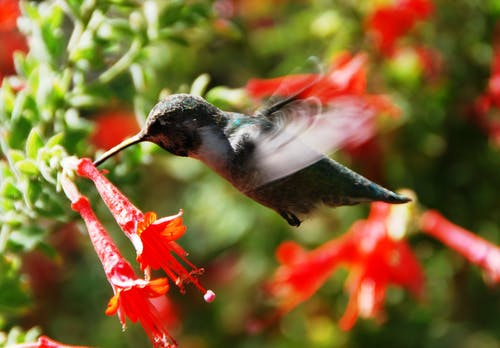
The Perennial Garden has become a home for a fascinating little creature, the hummingbird. Darting around the garden like tiny nectar hounds, these little entertainers have benefits you might not have considered. Hummingbirds are able to pollinate long-tubed flowers that can’t be reached by other birds that have short beaks and larger bodies. They also eat frequently, dining not only on nectar but also on insects and pollen. Their fast heartbeats and breathing require a lot of food so the good number of birds in the garden helps provide some natural assistance with certain small pests. Hummingbirds are specialized aerial hunters, and can snatch small insects from the air. They also glean insects from leaves and spider webs.
Hummingbirds prefer to nest near a ready supply of nectar and other food, and are encouraged to nest in the garden because of the shrubbery and small deciduous trees in which they can seek protective cover. They build their tiny, expandable nests on tree limbs and other small horizontal surfaces, often constructing them from lichens and spider webs. Hummingbirds will often perch to rest or survey their territory and need spots that are in the open and others that are in protected areas, hidden from view and buffered from cooler overnight temperatures.
So why are the hummingbirds attracted to the perennial garden? It has to do with the number of flowering plants and shrubs, particularly tubular flowers like fuchsias; a steady supply of flowers that bloom year-round, trees and shrubs that provide perches and nesting areas; and a pesticide-free garden which insures a healthy supply of insects.
So how can you attract hummingbirds? Pay attention to the plants in your garden, nesting and perching options, and allowing a healthy supply of insects.
Plants that attract hummingbirds: delphinium, liatris, foxglove, lobelia cardinalis, butterfly bush, nicotiana alata, weigela, salvia, yarrow, bee balm, lychnis chalcedonica, hollyhock, aquilegia canadensis
